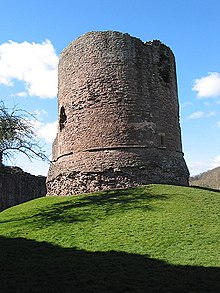Skenfrith Castle
| Skenfrith Castle | |
|---|---|
| Skenfrith, Monmouthshire, Wales | |

The Great Tower of Skenfrith Castle
|
|
| Coordinates | 51°52′42″N 2°47′25″W / 51.8784°N 2.7902°WCoordinates: 51°52′42″N 2°47′25″W / 51.8784°N 2.7902°W |
| Grid reference | grid reference SO457202 |
| Site information | |
| Open to the public |
Yes |
| Condition | Ruined |
| Site history | |
| Materials | Red sandstone |
Skenfrith Castle (Welsh: Castell Ynysgynwraidd) is a medieval castle located in Monmouthshire, Wales. The castle is in the centre of the village of Skenfrith, located on the banks of the River Monnow, five and a half miles north-west of the town of Monmouth. The first defences were built shortly after the Norman Conquest of 1066, although the remains of the castle that stand today date from the early thirteenth century. The castle is a Grade II* listed building as at 19 November 1953.
Grouped with White Castle and Grosmont Castle, Skenfrith is one of the "Three Castles" or Trilateral Castles built in the Monnow Valley as part of the Norman conquest of South Wales.
The Monnow Valley was an important route between Hereford and Monmouth in medieval times, due to its position as an area of relatively open land, which provided a break between the river cliffs of the Wye Valley to the east, and the hills around Abergavenny to the west. The Three Castles are usually grouped together by historians because for almost their entire history they were part of a block of territory under the control of a single lord.
All three sites have evidence for early Norman earthworks, possibly built by William fitz Osbern, who was made Earl of Hereford by William the Conqueror a few months after the Norman Conquest of England in 1066. From his castles at Monmouth and Chepstow, William was the first Norman lord to conquer central and eastern Monmouthshire, including the future sites for the Three Castles. The defences raised at this time would probably have been of earth and timber.
...
Wikipedia

